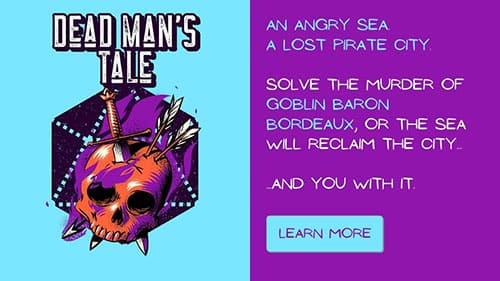Necromancers in Dungeons and Dragons 5e are masters of absorbing life and raising minions to do their bidding. Wizards in DnD 5e usually hold the group role of the intelligent master of the arcane—someone the rest of the party can turn to for answers. However, sometimes you just wanna make an evil character. So, let’s blend both worlds and build a party wizard who dabbles in the art of death.
To build a necromancer wizard in DnD 5e, consider the following:
- Choose a race that fits strategically and thematically: Yuan-ti and Tiefling
- Remember basic wizard attributes and abilities
- Lean into Necromancer school abilities and magic
- Choose spells for adventuring, necromancy damage and summoning
Before we dive in, why not try your necromancer in my spooky pirate adventure? Maps, items, a hidden lab, monsters and boss fights await. Click here or below to learn more.
Choose a race that fits strategically and thematically: Yuan-ti and Tiefling
For this build, we’ll want a race with an Intelligence bonus and splash of spooky—tieflings and yuen-ti purebloods.
A tiefling wizard receives a +2 Charisma/+1 Intelligence bonus and several inherent spells relating to fire and darkness. By level 3, a tiefling necromancer will know thaumaturgy and hellish rebuke (3d10, 2nd level). Plus, this character will be well versed in social skills with an inherently big Charisma score.
Yuan-ti purebloods are innately magical humanoids with snake-like features, gaining +2 Charisma and +1 Intelligence. Ancient rituals transformed this decadent race and granted them innate spellcasting and magical resistance. I can cast poison spray as a cantrip and animal friendship for snakes only. Also, I gain advantage on saving throws against magical effects and immunity to poison. This character would be like the villain Orochimaru from Naruto.
Remember basic wizard attributes and abilities
On my initial build, I’ll choose Arcana and Medicine as proficient skills—something that relates to zombie corpses and mysticism. I’ll also choose a dagger as a basic weapon because this feels more like a dagger guy and I might need some ritualistic sacrifice.
For my Spellbook, I’ll need to remember to collect the spells I need, pay 50 GP for the price of learning a new spell. However, at 1st level I’ll already know 3 cantrips and 6 level-1 spells. Each day, I can prepare a number of 1st-level spells from my spellbook equal to my Intelligence modifier + wizard level. If my Intelligence score is 16, I’ll have 3 + 1 spells available to use at level 1.
Ritual Casting allows me to cast a ritual spell whether it’s prepared or not. As long as it’s in my spellbook and I have the components, I can perform the ritual.
Spellcasting Focus offers me the ability to use an arcane focus (like a wand, ring, dagger, etc.) to cast my spells. If a spell states that a component must be consumed, I’ll have to have that component in my pouch. Otherwise, I can use my arcane focus in place of components for spellcasting.
The Arcane Recovery ability gives me the ability to recover some spell slots. The amount of spell slots recovered in this way is equal to half my wizard level in spell levels. A wizard at level 4 would either get 1 level-2 spell or 2 level-1 spells.
My highest-level wizard abilities are Spell Mastery (level 18) and Signature Spell (level 20). Spell Mastery gives me a level 1 and a level 2 spell to cast for free—no spell slot needed. Finally, Signature Spell gives me two 3rd-level wizard spells to cast, which are always prepared and don’t count against the number of spells I have prepared.
Lean into Necromancer school abilities and magic
At level 2, I will choose the School of Necromancy as my Arcane Tradition, which gives me several benefits to necromancy magic.
Necromancy Savant is the first ability I learn at 2nd level, which makes the gold and time I spend on copying a necromancy spell into my spellbook halved. Obviously, I’ll be leaning into these choices as I fill my spellbook, as I’ll gain more necromancy-related effects down the line.
Grim Harvest is another 2nd-level ability for my necromancer, which absorbs my enemies lifeforce when I kill them with a spell. I’ll gain hit points equal to twice the level of the spell or 3 times the level of the spell if it’s from the school of necromancy. At first, this looks like 2-6 hit points per enemy slain. However, level 3 and 4 spells jack that multiplier up to 9 and 12 hit points per enemy.
Undead Thralls at level 6 grants me the animate dead spell if I don’t already have it, along with several features for my zombies or skeletons.
- I can summon a second thrall when I cast animate dead.
- My thrall’s HP max is increased by an amount equal to my wizard level.
- Add my proficiency bonus to thrall’s weapon damage.
Inure to Undead gives me defensive capabilities against my own magic—giving me resistance to necrotic damage and a HP max that can’t be magically lowered.
Command Undead is my ultimate necromancer ability, giving me the power to take control of another undead creature I didn’t create—even those summoned by other wizards. I choose an undead creature I can see within 60 feet and that creature must make a Charisma saving throw. On a failed save, it is mine. Undead with an Intelligence of 8 or higher are harder to control, gaining advantage on the saving throw. An undead with Intelligence of 12 and higher can make this saving throw every hour.
Choose spells for adventuring, necromancy damage and summoning
Choosing spells for my necromancer is a fun process—I’ll need to be sure and cover necromancy spells, summoning spells, typical wizard adventuring spells and spells to cover my defense. For this build, I’m going to play a distance strategy, so I don’t anticipate jumping into melee combat. Instead, I’m going to work the field in a support/damage role. I might even be a little sinister about it.
Learn more about creating a necromancer backstory/aesthetic in the video below:
Cantrips
My cantrips will include basic damage capabilities and adventuring options I can use repeatedly. Therefore, I’ll want to choose these freebie spells wisely.
- Chill Touch: A ghostly, skeletal hand reaches out to strike a target as a ranged spell, dealing 1d8 necrotic damage. The hand holds on until the beginning of my next turn, preventing the target from gaining life until then. At level 5, 11 and 17, the damage increases by 1d8.
- Mage Hand: Another ethereal hand stretches out to manipulate objects at a distance. I’m all about the ghost hands, and this one has many uses.
- Minor Illusion: I can make a target believe they are seeing something small that isn’t there—a whisper, a small animal or a strange smell.
- Fire Bolt: A blast of fire deals 1d10 fire damage and ignites flammable material. I’ll use this early in combat as a high-power option, finishing my opponents with a necromancy spell for Grim Harvest.
1st-level spells
- Ray of Sickness: An ugly, green beam deals 2d8 poison damage—a more powerful contender from the school of necromancy for the Grim Harvest than chill touch.
- Shield: Add +5 to my AC and negate magic missile I don’t plan on being up close, but one good defensive spell can make a major difference.
- False Life: Use necromancy to bolster life force, adding 1d4 +4 temporary HP for 1 hour.
- Unseen Servant: I can create an invisible entity of magic to do my bidding. They can’t fight, but they can run errands or test dangerous areas. I see this as my first dip into controlling otherworldly creatures.
2nd-level spells
- Ray of Enfeeblement: Another treat from the school of necromancy, this spell halves my foe’s Strength damage on hit. At the end of my opponent’s turns, they must throw a Constitution save to break the spell.
- Detect Thoughts: This spell allows me to read the surface thoughts of a creature, probing deeper on a second action against a Wisdom saving throw. This also can be used to detect thinking creatures within 30 feet of me. I like this spell for its functional use and creep factor.
- Invisibility: I can turn invisible—the perfect escape from a dangerous situation. I’m far to slippery to be caught so easily. Plus, creepy.
- Misty Step: Teleport to a space within 30 feet of me. Again, I’m like a supervillain that always seem to get away.
3rd-level spells
- Animate Dead: This spell raises a zombie thrall under my command—the bread and butter of necromancers everywhere.
- Vampiric Touch: Deal 3d6 necrotic damage and recover half as much HP.
- Counterspell: Spells at level 3 or lower are immediately countered. Any spell above level 3 forces me to make a DC check with my spellcasting ability equal to 10 + spell’s level.



Super helpful! Was very useful in the process of creating a necromancer.